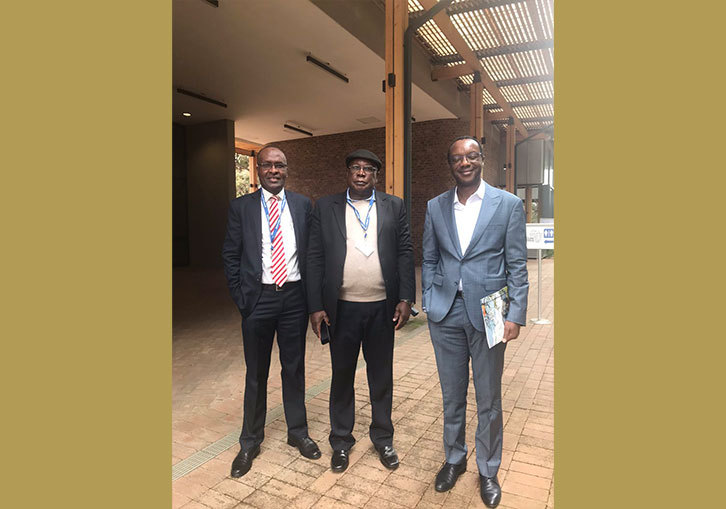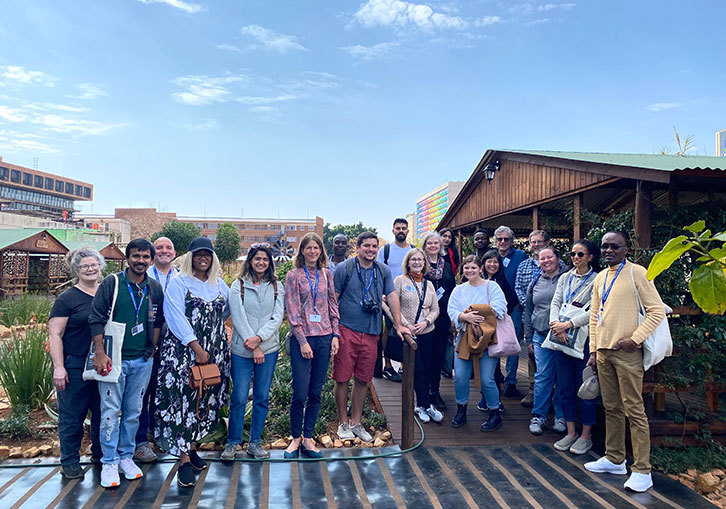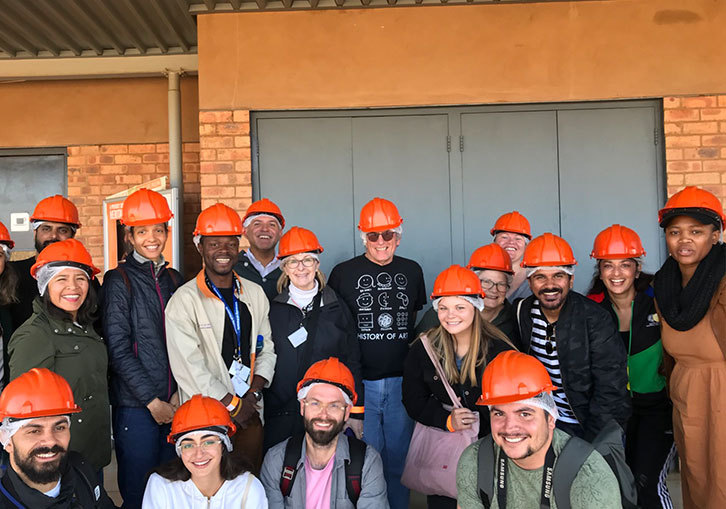Pauline Strong, former director of the University of Texas Humanities Institute of the University of Texas at Austin, reflected on the CHCI/Mellon Global Humanities Institute on Climate Justice and Problems of Scale hosted at the University of Pretoria July 29th - August 7th. The GHI website has more information about the conference, participants, and, program. Recorded events will be uploaded to the website soon. The following is a lightly edited transcript of our conversation as Pauline Strong discussed the experience.

The CHCI/Mellon Global Humanities Institute on Climate Justice, and Problems of Scale hosted at the University of Pretoria occurred this summer. What was the process of organizing this international event?
Pauline Strong: This was a collaboration of six CHCI institutions. The University of Texas at Austin took the lead, and I was the P. I. for this project, but it couldn't have been done without my team here at the University of Texas at Austin. I worked with several scholars who are involved with a grand challenge here called Planet Texas 2050 and that's Heather Houser, Katherine Lieberknecht, and Adam Rabinowitz, and also with my assistant director in the Humanities Institute here Melissa Biggs. I worked with scholars at five other institutions, including James Ogude and his team at the Centre for the Advancement of Scholarship at the University of Pretoria. Professor Ogude offered to be our host, and those of us who were able to travel to South Africa, stayed on the Future Africa campus, which is just a wonderful place to hold a conference. In addition to facilities, hotel facilities, dining facilities, and conference facilities, we were surrounded by gardens. The Future Africa campus grows some of its own food, and the gardens are just beautiful. So we had a real taste of the landscape of South Africa, beginning there and then extending into our field trips.
Then another international partner was the American University of Beirut in Beirut, Lebanon. I worked with Robert Myers and his team there. These people were all involved in planning at the Institute. Some were not able to come to Pretoria, but five of the six institutions did send representatives to Pretoria, and all of them were represented on the program, some of them via Zoom. So from Beirut we had a panel on artistic and environmental activism. We also had two early career scholars who came and talked about the activist work they are doing in Lebanon around land justice and environmental justice.
The third international partner was the University of Sydney. Thom van Dooren, David Schlosberg, and Christine Winter all participated in planning and participated via Zoom. They brought an orientation towards multi-species justice to our program.
Two other U.S. institutions, fourth, Arizona State University, Joni Adamson and Joan McGregor were the leads there. Joni Adamson did join us in Pretoria. Finally Carnegie Mellon University, and David Shumway was the lead, and joined us in Pretoria. So we had altogether 43 participants in the Global Humanities Institute, and 25 of these were on site and were able to participate in the full range of activities.
The planning took several years. Our first meeting was planned for May 2020 and we had to move that online because of the pandemic. We had originally planned for the GHI to occur in the summer of 2021 and that was not possible. We really were committed to an on-site event. So we waited until the summer of 2022, when most of our team felt comfortable traveling to South Africa. I've told you mainly about the senior scholars who are involved in the planning process. We also recruited others to participate. We also recruited nineteen early career scholars, fourteen of them were able to travel to Pretoria to participate on site, and five of them participated via zoom or Youtube in the case of the lectures. So we were very, very pleased with the reception to our invitation, our call for applications. It was a very competitive pool of scholars, artists, and activists. The nineteen that we chose came from Africa, the Middle East, Canada, South Asia, and from the U.S. So we had a wide variety of regions represented as well.
Thank you. That's always great to hear when collaboration works so well.
Pauline Strong: Having six institutions is, of course, a complicated process to collaborate with that many people to plan something, but it brought a great deal of depth and richness to the program.

There were several workshops, lectures, and panels. What were some of the highlights for you of these important conversations?
Pauline Strong: You know I thought every single lecture, workshop, panel, and field trip contributed in an important way to the overall experience and knowledge that we gained. In some ways, perhaps, the field trips were highlights for everybody, for those of us who were in Pretoria because we were able to experience some of the landscapes of South Africa as well as urban space and the Javett Arts center at the University of Pretoria. That wasn't really a field trip, but it was a special event that opened the GHI and we got to experience traditional and contemporary African art. The University of Pretoria were great hosts and arranged these really memorable events for us.
Now the people who weren’t on site were not able to participate in the field trips, but we did organize several virtual artistic events. The artist Beili Liu talked about her work, about artistic activism, and especially her recent work in the Arctic, so that brought a new region into our purview. The Humanities Scholar Gretchen Henderson showed a film that she had made about Great Salt Lake, and really looking at the scale of that place. The poet Ojo Taiye from Nigeria, who was an early career scholar, did a poetry reading for us, and much of his poetry is about the environment. So those were all extremely notable events. I would also say that the more academic events, the lectures, the panels, and the workshops, were all really memorable, and contributed to a developing kind of understanding among ourselves about the meanings of climate justice, the roots of climate injustice, and various ways of thinking about the scale of this problem and how to address the scale of this problem.

You have touched on it a bit, but if you could expand on the field trips to the University of Pretoria Moja Gabedi Garden and Sanbi Pretoria National Botanical Gardens. How were these trips? And how did they speak to the themes of the GHI?
Pauline Strong: Our first trip was to the Moja Gabedi Community Garden, which is a community engagement project of the University of Pretoria [see photo above and also at the top of this interview]. It's in an urban environment, and it is a place for people who are recovering from addiction who work in the gardens and also are able to socialize in the garden. It's a beautiful space surrounded by urban buildings before it became a community garden it was a very neglected environment. We got to see many kinds of plant life. Our guides showed us many kinds of plant life, but we also really could see what people are able to do when they put their minds to it. To see how people are able to transform a landscape, and by transforming a landscape, how they transform people's lives. So it was very, very inspirational to go to this community garden and a really wonderful example of community engagement on the part of a university, which is something that many humanities centers and institutes are involved in.
We also went to a more established garden, the Sanbi Pretoria National Botanical Gardens, where we again saw many kinds of plants that are indigenous to South Africa. Some of us got to visit a herbarium where scientists record the various species, and that was really exciting for those of us who got to see that. But we all enjoyed a day in the fresh air. It was about halfway through the Institute. The Institute was a very intense experience. We had activities sometimes from 8:30 in the morning till 9:00 or later at night. So that morning we just got to wander around the beautiful botanic gardens and have a lovely lunch refreshed by the environment. Of course, since we're thinking about climate justice, we're thinking about people's access to beautiful spaces, people's access to clean air, fresh water, and open landscapes. We were able to experience a place that is set aside for the use of the public, and a very different kind of garden.
We took a couple of other field trips on the last day of the Institute. We went to a lion and rhino game preserve. We got to ride around in an open-air bus, and we saw lions, we saw rhinos, and we saw many other animals. That was really exciting, many photos were taken. That again showed us the savannah landscape of South Africa. On the way to the lion and rhino reserve we went to a World Heritage site, where one of the earliest Australopithecine skulls and sets of bones had been found. We went down into these mines. We went into these caves, and had a very adventurous excursion to see where these bones were found. This is a World Heritage site. So it's always exciting when you are traveling to be able to go to a world heritage site. And how did this connect to our themes? Well, environmental issues, of course, go back to the earliest years of humanity and our ancestors. This was a place where the bones were preserved, because people fell into these caves when they were hunting, or when they were being chased by game, and it just gave us a feeling of the longevity of human and hominid history, but also the beauty of this environment underground.

You hosted a workshop titled, “Envisioning the Future of the Global Humanities Institute” so what do you think were some of the important takeaways from that workshop and what is your vision of the future of the Global Humanities Institute?
Pauline Strong: Our institute was organized along three themes, and one had to do with scale. How can we conceptualize the scale of climate change, the scale of the challenge, the relationship between local activities and more global kinds of impacts, scale across time and across space? We had people address that from the point of fiction, art, and activism. Our second theme was climate justice. So we had people talk about what climate justice means in their particular context, and this, of course, has a lot to do with the justice system of a particular region. How does nature have rights as it does in South Africa, which is a fairly new constitution? We learned a lot about different ways of thinking about what environmental justice is, and ways of thinking about it that is not only human-centered but it involves multi-species justice. And then our third was looking at climate injustice, and activism around the world. We had many examples of both local and regional and global activist organizations that are working to address climate change and achieve climate justice. Along those three lines of inquiry we had many contributions from senior scholars, from early career scholars, from artists, and from activists.
In our closing workshop it became really clear that we have the opportunity to publish a volume or perhaps more than one volume of proceeds from the conference. We are also going to make recordings from the conference public and we will continue to be in contact with each other. One of our senior scholars, Dr. Iva Peša, suggested that we have a writing workshop and so those who want to be involved in a writing workshop that will allow people to share their work, get feedback on their work, and work towards a publication will be able to continue to participate in that. We will have a variety of post-Institute activities, and one we haven't set a date for it yet, but we will have a virtual reunion where we can share what we've been doing. It'll probably be this spring. We can share how we have been working separately and together to continue to work on these issues. So I'm very excited about what we will do, moving forward and how we will be able to share what we learned with a broader audience and continue to work together.
Is there anything else you'd like to share about the GHI Conference?
Pauline Strong: I'm just really really grateful to CHCI and the Mellon foundation for funding this initiative. I think it was really successful. The response from both the senior scholars and the early career scholars was very enthusiastic. People found it very stimulating for their own work. Being able to actually be together for the 25 of us who could do that was really valuable, because we had a lot of informal conversations over meals and on our field trips. We were glad, though, to also include people who were not able to come to Pretoria. So the hybrid format, although it poses challenges, really paid off. I'm really grateful to the AV team at the University of Pretoria, who just did amazing work setting up our hybrid facilities. And then I'm very, very grateful to the team at the University of Pretoria for their extraordinary hospitality, and to all the members of the six institutions who helped plan this GHI. It's been a very fulfilling experience. It's not over, but I'm very grateful for the skills, thoughtfulness, energy, and the enthusiasm that everyone brought. On the website, I've thanked people by name, so I won't do it here. There's so many people to thank, but I do really want to make a point of thanking CHCI for making this possible and the Mellon Foundation for funding it.